It’s a guessing game that builds up to every first Friday of the month. The monthly change in nonfarm payroll employment is seen by the vast majority of traders, investors, economists, and policymakers as the most important economic indicator. The magnitude and direction of nonfarm payroll employment can result in major market moves. And the release sets the mood for the rest of the month. Given the amount of money riding on the nonfarm payroll number, traders and investors try to anticipate this figure as much in advance as possible—and they keep refining estimates all the way until the day before first Friday. So, what indicators provide some advance warning on where the Labor Department’s payroll data are headed' Each precursor indicator has different coverage and pluses and minuses. Let’s review the precursors by the typical schedule of economic releases, starting with the earliest available. And you probably will be surprised at how many economic releases provide hints at the payroll employment outcome.
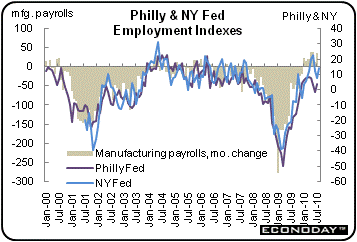 The first indicators on the economic calendar to give insight into the coming payroll employment number are the Philadelphia Fed in New York Fed manufacturing surveys. The Philly Fed report comes out in the third Thursday of each month for that month. The New York Fed survey-also known as the Empire State Manufacturing survey-is released about the 15th of the month for the month. The first indicators on the economic calendar to give insight into the coming payroll employment number are the Philadelphia Fed in New York Fed manufacturing surveys. The Philly Fed report comes out in the third Thursday of each month for that month. The New York Fed survey-also known as the Empire State Manufacturing survey-is released about the 15th of the month for the month.
Both are known as diffusion indexes, meaning that they showed the net change in direction of the survey respondents. The two surveys, of course, have headline indexes, but both also have sub-indices for employment. For each, a figure above zero indicates positive growth, with higher figures representing more rapid growth.
The key benefit of these two series is the early, release date, providing a very early indication of the direction of payroll employment. However, because these are manufacturing indexes it is more appropriate to use these to anticipate the manufacturing component of payroll employment. The shortcoming also is related to the release date. Data for any given month actually reflect responses from two different months-the second half of the prior month and the first half of the current month. So, timing does not precisely match that for the Labor Department's payroll data.
Another shortcoming of these two indexes is that they both are regional indexes instead of having national coverage. The Philly Fed index covers the northern portion of mid-Atlantic states while the Empire State survey includes only manufacturers in New York State.
These two employment indexes do not always move in tandem each month. Currently, the Philly Fed index is weaker than the Empire State employment index. For the upcoming BLS employment report, the two indexes point in opposite directions for manufacturing employment. The Philly and Empire indexes came in at minus 2.7 and plus 14.3, respectively.
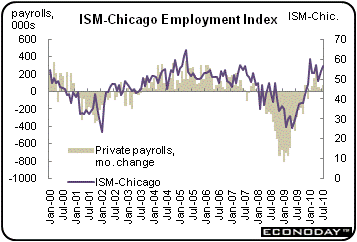 Next on the calendar is the ISM-Chicago Business Survey. The headline series is known as the Chicago Business Barometer—but is commonly referred to as the Chicago PMI. Before the official name change, it was the Chicago-NAPM for National Association of Purchasing Management with the headline index called the purchasing managers’ index (PMI). Next on the calendar is the ISM-Chicago Business Survey. The headline series is known as the Chicago Business Barometer—but is commonly referred to as the Chicago PMI. Before the official name change, it was the Chicago-NAPM for National Association of Purchasing Management with the headline index called the purchasing managers’ index (PMI).
The survey is released the last business day of the month for reference month (July data released at the end of July), and it includes an employment diffusion index. Coverage includes the greater Chicago economy with survey respondents in a variety of sectors including manufacturing, construction, and services. This is the first economic report of the month that covers more than just the manufacturing sector.
In contrast to the Philly Fed and New York Fed diffusion indexes, this report’s indexes, breakeven point is 50. Above 50 is analogous to positive growth with higher numbers indicative of a faster pace of growth.
While timeliness is a positive for this employment index, a short-coming is that it is largely a metropolitan index, albeit an important one. However, over the past recession and recovery, this employment index has largely tracked U.S. private payrolls but with greater monthly volatility. The greater volatility is largely due to the surveys relatively small sample size. The survey panel is primarily drawn from the membership of the Institute for Supply Management-Chicago.
For the upcoming August payroll number, the Chicago-PMI employment index with a 56.6 reading suggests a modest rise in payroll jobs for the month.
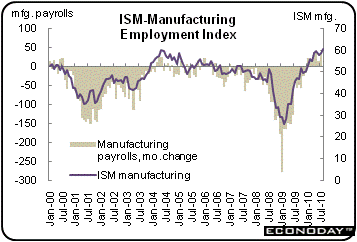 The Institute for Supply Management’s ISM) monthly manufacturing survey is posted the first business day after the reference month (August data are published in September). This is the first national manufacturing survey to be released each month, giving it a lot of attention. The Institute for Supply Management’s ISM) monthly manufacturing survey is posted the first business day after the reference month (August data are published in September). This is the first national manufacturing survey to be released each month, giving it a lot of attention.
The survey does have a moderate sample size, based on about 300 of ISM’s members. The employment index is one of the five components that make up the headline composite index. Once again, you have to pay attention to what the breakeven point is—50 and not zero. As with other employment indexes in manufacturing surveys, it is more appropriate to use it to project the manufacturing component in BLS payroll data than overall or private payrolls.
The August numbers were just released and suggest a moderate gain for payroll employment in the manufacturing sector for this Friday’s employment situation. The ISM employment index rose to 60.4 from 58.6 in July.
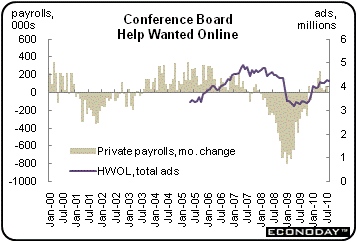 Next out of the gate each month is the Conference Board’s Help Wanted Online (HWOL) report. It generally is released the Monday just before the first Friday of each month. This report is a relative newcomer, with data going back to July 2005. The Conference Board outsources the collection of online ad data to a private consulting firm which collects online ads from over 1200 job boards in the United States, covering both online newspaper ads and internet job board ads. This report includes numbers for total ads and for new ads. Next out of the gate each month is the Conference Board’s Help Wanted Online (HWOL) report. It generally is released the Monday just before the first Friday of each month. This report is a relative newcomer, with data going back to July 2005. The Conference Board outsources the collection of online ad data to a private consulting firm which collects online ads from over 1200 job boards in the United States, covering both online newspaper ads and internet job board ads. This report includes numbers for total ads and for new ads.
Due to its newness, it is not yet clear what the relationship of the HWOL data is to private payrolls. A notable issue is that during the early years of the development of the HWOL data, companies were making a major shift in recruiting strategies—moving from traditional ads in newspapers to online sites. Growth in online ads was rapid over the 2005 through 2006 period—in contrast to a moderate in payroll employment growth. For now, this index may be more of a leading indicator of the employment trend rather than a good predictor of monthly movement in payroll jobs.
For August, total ads slipped but likely remain on an uptrend going back to late 2009.
Econoday plans to add the Conference Board’s Help Wanted Online headline numbers to its web calendar in the near future.
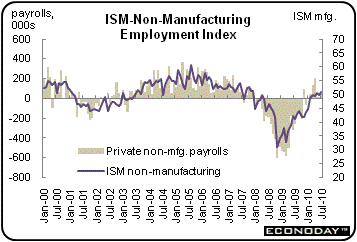 The Institute for Supply Management also produces a non-manufacturing survey, covering construction and services industries. The report is released the third business day of each month with the reference month being the prior month. The headline index includes an employment index subcomponent. The Institute for Supply Management also produces a non-manufacturing survey, covering construction and services industries. The report is released the third business day of each month with the reference month being the prior month. The headline index includes an employment index subcomponent.
The sample size for the survey is moderate—about 400 of ISM members. One can compare changes in the employment diffusion index with overall payroll employment or even private payrolls. But the closest relation is to private payrolls excluding manufacturing.
Like the ISM manufacturing indexes, the breakeven mark for the non-manufacturing series is 50. The August report had not yet been released at time of publication.
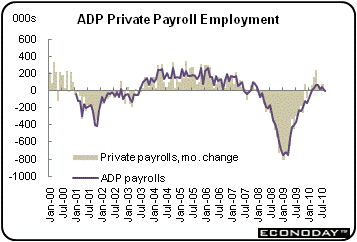 Probably the best known precursor indicator for the payroll portion of the employment situation is the Automatic Data Processing (ADP) National Employment Report. It usually prints two days before the employment situation—generally, of course, on Wednesday before first Friday. ADP is in the data processing business with much based on processing payrolls for companies. Data come from a confidential sample of processed payrolls. ADP hired a consulting firm, Macroeconomic Advisors to do the final compiling and to make adjustments to the sample to conform to the national shares of employment by industry. The report receives much market attention because the sample is very large—averaging about 340,000 businesses and covering roughly 21 million employees as of June 2010. The survey only covers the private sector—no government workers are included. Probably the best known precursor indicator for the payroll portion of the employment situation is the Automatic Data Processing (ADP) National Employment Report. It usually prints two days before the employment situation—generally, of course, on Wednesday before first Friday. ADP is in the data processing business with much based on processing payrolls for companies. Data come from a confidential sample of processed payrolls. ADP hired a consulting firm, Macroeconomic Advisors to do the final compiling and to make adjustments to the sample to conform to the national shares of employment by industry. The report receives much market attention because the sample is very large—averaging about 340,000 businesses and covering roughly 21 million employees as of June 2010. The survey only covers the private sector—no government workers are included.
Despite the large sample size, however, the monthly change in ADP private payroll employment have had what some would call only moderate success in predicting the change in BLS’s private payroll figure for the same month and reported two days later. Nonetheless, the ADP data have tracked the same trend as the government-produced numbers.
Based on just released data for August, ADP is predicting a 10,000 drop in private payrolls.
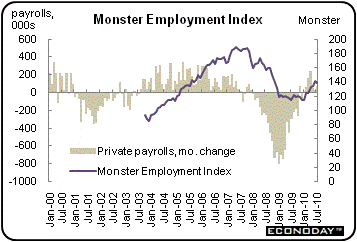 The Monster Employment Index (MEI) is produced by Monster.com and is the original index that measures online ad activity with data going back to October 2003. The report is released the day before the Labor Department’s employment situation report. While Monster.com, of course, is an online site for posting job ads, the company uses software to crawl not just its site but dozens of others to compile the index. The Monster Employment Index (MEI) is produced by Monster.com and is the original index that measures online ad activity with data going back to October 2003. The report is released the day before the Labor Department’s employment situation report. While Monster.com, of course, is an online site for posting job ads, the company uses software to crawl not just its site but dozens of others to compile the index.
Similar to the difficulty with the Conference Board data, there was a rapid rise in ads in the early years of the index due to a shift from traditional recruitment to more companies using online resources. This means initial years do not exactly track economic trends in payroll employment. In contrast to the Conference Board data, the Monster numbers are not seasonally adjusted.
The latest few months of MEI data suggest continued moderate growth private payroll employment. August data were not available at the time of this publication.
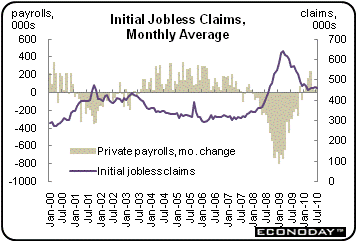 The final employment data released just before the employment situation report is the Labor Department’s initial jobless claims. This is a weekly report released each Friday for claims for the week ending Saturday before the release date. The numbers are the product of a cooperative effort between state and local unemployment agencies with the federal Employment and Training Administration (ETA). Local agencies compile the claims numbers and forward to state agencies which forward to the ETA. The final employment data released just before the employment situation report is the Labor Department’s initial jobless claims. This is a weekly report released each Friday for claims for the week ending Saturday before the release date. The numbers are the product of a cooperative effort between state and local unemployment agencies with the federal Employment and Training Administration (ETA). Local agencies compile the claims numbers and forward to state agencies which forward to the ETA.
The best feature of the initial claims report is its timeliness. But weekly data are difficult to seasonal adjust—especially around holidays.
Still, the monthly average can be used to predict the upcoming payroll number. The idea is that higher initial claims are associated with weak or negative payroll figures. They are inversely related. Some analysts prefer to forecast with initial claims with the week that includes the 12th of each month. Payroll numbers are based on company pay reports that include the 12th of each month.
Based on the first three weeks of data for August, initial claims are notably higher at 488,000 for the month’s average compared to 459,000 for July. This suggests a softer private payroll gain for August than July.
Because employment has become the major issue for the economy, more traders, analysts, and policymakers have been looking for ways to get a better handle on where employment is headed—whether stronger or weaker. There is no shortage of data to peruse ahead of the first Friday jobs report. The “consensus” among the precursor indicators is that private payrolls in August will post somewhere between a modest decline and a modest rise. And two of the three major manufacturing surveys call for a moderate rise in manufacturing employment. But as a major caveat, the jobs data have surprised many times in the past.
|

